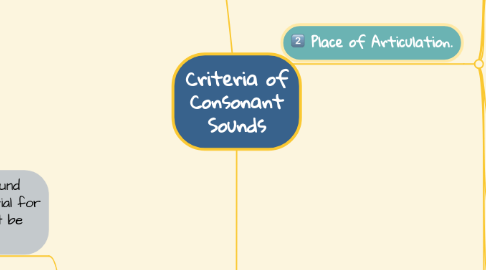
1. Manner of articulation.
1.1. This area is called manner, which is how the air is released for each sound.
1.2. Stops
1.2.1. They are made by narrowing the vocal tract at some point, and when the air passes through, you hear a turbulent sound.
1.2.1.1. English has 6 stops:
1.2.1.1.1. P /p/
1.2.1.1.2. B /b/
1.2.1.1.3. T /t/
1.2.1.1.4. D /d/
1.2.1.1.5. K /k/
1.2.1.1.6. G /g/.
1.3. Fricatives
1.3.1. They are made by narrowing the vocal tract at some point, and when the air passes through, you hear a turbulent sound.
1.3.1.1. English has 9 fricatives:
1.3.1.1.1. F /f/
1.3.1.1.2. V /v/
1.3.1.1.3. TH /θ/
1.3.1.1.4. TH /ð/
1.3.1.1.5. S /s/
1.3.1.1.6. Z /z/
1.3.1.1.7. SH /ʃ/
1.3.1.1.8. ZH /ʒ/
1.3.1.1.9. H /h/.
1.4. Affricates
1.4.1. They are a combination of stop consonant and a fricative.
1.4.1.1. English has 2 affricates:
1.4.1.1.1. CH /ʧ/
1.4.1.1.2. J /ʤ/.
1.5. Nasals
1.5.1. These are sounds in which the air flow passes through the nose instead of the mouth.
1.5.1.1. English has 3 nasals:
1.5.1.1.1. M /m/
1.5.1.1.2. N /n/
1.5.1.1.3. NG /ŋ/.
1.6. Liquids
1.6.1. They are made when the tongue makes a partial closure in the mouth.
1.6.1.1. English has 2 liquids:
1.6.1.1.1. L /l/
1.6.1.1.2. R /ɹ/.
1.7. Glides
2. Phonation (voice)
2.1. Phonation is the process of sound production. Where air is essential for sound production (sound cannot be produced without air).
2.1.1. These are similar to liquids in that the tongue and lips make a partial closure in the mouth, but with a glide there is movement in the sound between two places of articulation.
2.1.1.1. English has 2 glides:
2.1.1.1.1. W /w/
2.1.1.1.2. Y /j/.
2.1.2. Types:
2.1.2.1. Voiced
2.1.2.1.1. If the vocal cords vibrate while pronouncing the consonant.
2.1.2.2. Voiceless
2.1.2.2.1. If the vocal cords DO NOT vibrate while pronouncing the consonant.
2.2. To produce sound, the air from the lungs is pushed up through the glottis (opening between the vocal folds) that causes pressure to drop in the larynx, which makes the vocal folds vibrate and produce physical sound.
2.3. The voiced sounds are:
2.3.1. B /b/
2.3.2. D /d/
2.3.3. G /g/
2.3.4. V /v/
2.3.5. TH /ð/
2.3.6. Z /z/
2.3.7. ZH /ʒ/
2.3.8. J /ʤ/
2.3.9. M /m/
2.3.10. N /n/
2.3.11. NG /ŋ/
2.3.12. L /l/
2.3.13. R /ɹ/
2.3.14. W /w/
2.3.15. Y /j/.
2.4. The voiceless sounds are:
2.4.1. P /p/
2.4.2. T /t/
2.4.3. K /k/
2.4.4. F /f/
2.4.5. TH /θ/
2.4.6. S /s/
2.4.7. SH /ʃ/
2.4.8. H /h/
2.4.9. CH /ʧ/.
3. Place of Articulation.
3.1. Bilabial
3.1.1. Bilabial consonants occur when you block/constrict airflow out of the mouth by bringing your lips together.
3.1.1.1. English contains the following three bilabial consonants:
3.1.1.1.1. /p/ as in “purse” and “rap“
3.1.1.1.2. /b/ as in “back” and “cab“
3.1.1.1.3. /m/ as in “mad” and “clam“
3.2. Labio-Dental
3.2.1. Labio-dental consonants occur when you block/constrict airflow by curling your lower lip back and raising it to touch your upper row of teeth.
3.2.1.1. English contains the following two labio-dental sounds:
3.2.1.1.1. /f/ as in “fro” and “calf“
3.2.1.1.2. /v/ as in “vine” and “have”
3.3. Dental
3.3.1. Dental consonants occur when you block/constrict airflow by placing your slimy tongue against your upper teeth.
3.3.1.1. English contains the following two labio-dental sounds:
3.3.1.1.1. /θ/ as is “thick” and “bath“
3.3.1.1.2. /ð/ as in “the” and “rather”
3.4. Alveolar
3.4.1. You create Alveolar consonants when you raise your tongue to the alveolar ridge to block or constrict airflow.
3.4.1.1. The English alveolar consonants are as follows:
3.4.1.1.1. /n/ as in “no” and “man“
3.4.1.1.2. /t/ as in “tab” and “rat“
3.4.1.1.3. /d/ as in “dip” and “bad“
3.4.1.1.4. /s/ as in “suit” and “bus“
3.4.1.1.5. /z/ as in “zit” and “jazz“
3.4.1.1.6. /l/ as in “luck” and “fully”
3.5. Post-alveolar
3.5.1. When you retract your tongue back just a bit from the alveolar ridge, the sounds change enough to be recognized as distinct consonants.
3.5.1.1. The post-alveolar english consonants are as follows:
3.5.1.1.1. /ʃ/ as in “shot” or “brash”
3.5.1.1.2. /ʒ/ as in “vision” or “measure”
3.5.1.1.3. /tʃ/ as in “chick” or “match”
3.5.1.1.4. /dʒ/ as in “jam” or “badge“
3.6. Palatal
3.6.1. You create Palatal consonants when you raise the tongue to this point and constrict airflow.
3.6.1.1. English has only one palatal consonant:
3.6.1.1.1. /j/ as in “yes” and “bayou”
3.7. Velar
3.7.1. You make Velar Consonants when you raise the back of your tongue to the velum to block or restrict airflow.
3.7.1.1. English has the following velar consonants:
3.7.1.1.1. /ŋ/ as in “going” and “uncle”
3.7.1.1.2. /k/ as in “kite” and “back“
3.7.1.1.3. /g/ as in “good” and “bug“
3.7.1.1.4. /w/ as in “wet” and “howard”
3.8. Glottal
3.8.1. The glottis is actually two vocal folds (i.e. vocal cords). It acts as a sort of bottle cap to your windpipe. Glottal consonants aren’t actually consonants; they just play consonant roles in the language.
